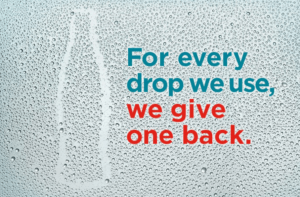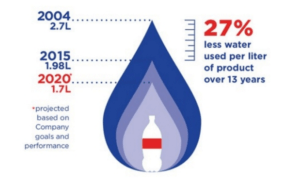Coca-Cola: Taking the air right out of bubbling climate change issues

When Coca-Cola lost significant business in India in 2004 due to a local water shortage, they quickly realized how dire this global climate change situation could be and jumped into action. Now in 2016, we see what astounding progress they have made, but there is still more to be done.
Global warming is affecting the world in unimaginable ways. Droughts are commonplace, resources are scarce, and globally we are facing unpredictable and massive storms. Not only is this bad for the environment, but its effects are transcending weather trends and greatly impacting corporations and economies at large. Because of the global nature of our economies today, we can’t turn a blind eye to issues internationally; international concerns can have catastrophic impacts for US-based companies. For Coca-Cola, it wasn’t until 2004 when they lost significant business in India due to a local water shortage, they quickly realized how dire this situation could be and jumped into action.[i]
What Coca-Cola quickly realized in 2004 is that while they would be impacted by many issues related to global warming, sustainable access to clean water is pertinent to future success. Not only is water the main ingredient in their beverages, but it is also a critical component of the manufacturing processes, a key input to agriculture for other raw materials, and the communities where they bottle the products are also their end consumers, so they have a vested interest in keeping these communities thriving.[ii] Their action planning included setting some ambitious goals; in 2007 Coca-Cola defined one of their goals as “replenishing every liter of water used in its global sales volume and production by the end of 2020.”[iii]
Now let’s flash-forward to current-day, 2016. No-one could have predicted this rapid success, but in August, Coca-Cola announced that they achieved this ambitious target 5 years ahead of schedule. In fact, just last year, Coca-Cola replenished 191.9 billion liters of water, representing 115% of the water it took out of these communities.[iv] Coca-Cola has achieved this replenishment goal by supporting 248 community water projects across 71 countries, impacting 2,000 communities.[v] These projects have been in partnership with a variety of partners including the World Wildlife Fund, USAID, The Nature Conservancy, CARE and UNDP[vi] and have a focus along one of the following four objectives:
- provide safe water access;
- restore and protect watersheds; and/or
- support water for productive use.[vii]
Source: http://www.brandchannel.com/2016/08/29/coca-cola-pepsico-water-082916/
In addition to replenishing the water they consume, Coca-Cola has also made huge strides since 2004 against another water-related goal of improving the efficiency of the water it uses. Just last year, Coca-Cola was able to improve its efficiency by 2.5%, adding to the cumulative 27% improvement they have achieved since 2004. In 2015, Coca-Cola was able to produce 1 liter of product by using only 1.98 liters of water, marking the first year where Coca-Cola’s water-use ratio fell below 2. While this is astounding progress, their ultimate goal is to get this down to 1.7 liters to produce 1 liter of product by 2020.[viii] There are already multiple plants across the globe which are operating with less than 1.7 liters already, with some operating as low as 1.4 liters.
Source: http://www.coca-colacompany.com/stories/waterreplenishment2016
It is inspirational to have company that is traditionally revenue-driven take a strong stand on the direct environmental impact it has as a company and the sustainability of the markets in which it operates, but their work can’t stop here. For one, showcasing this level of concern for sustainability is almost table stakes in this day in age. Coca-Cola’s biggest competitor, Pepsi, is also competing on this front and reported a 26% reduction in water usage since 2006.[ix] Coca-Cola must continue to push for more improvements to its environmental footprint and be a leader both within CPG companies and across industries to show other companies why this is so important. While the progress thus far has been astronomical, the wins going forward will be even harder to achieve. Coca-Cola must look to innovation and technology to continue to find improvements in their systems and to continue pushing for greater access to clean water globally.
(734 words)
[i] New York Times, “Industry Awakens to Threat of Climate Change,” http://www.nytimes.com/2014/01/24/science/earth/threat-to-bottom-line-spurs-action-on-climate.html?_r=0, accessed November 2016.
[ii] Coca-Cola, “Water Stewardship,” http://www.coca-colacompany.com/sustainabilityreport/world/water-stewardship.html, accessed November 2016.
[iii] Coca-Cola, “Watershed Milestone: Coca-Cola is First Fortune 500 Company to Replenish All Water Used Globally,” http://www.coca-colacompany.com/stories/waterreplenishment2016, accessed November 2016.
[iv] Coca-Cola, “Watershed Milestone: Coca-Cola is First Fortune 500 Company to Replenish All Water Used Globally,” http://www.coca-colacompany.com/stories/waterreplenishment2016, accessed November 2016.
[v] Coca-Cola, “Infographic: Water Replenishment,” http://www.coca-colacompany.com/our-company/water-replenishment-infographic, accessed November 2016.
[vi] Coca-Cola, “Water Stewardship,” http://www.coca-colacompany.com/sustainabilityreport/world/water-stewardship.html, accessed November 2016.
[vii] Coca-Cola, “Infographic: Water Replenishment,” http://www.coca-colacompany.com/our-company/water-replenishment-infographic, accessed November 2016.
[viii] Coca-Cola, “Improving our Water Efficiency,” http://www.coca-colacompany.com/stories/setting-a-new-goal-for-water-efficiency, accessed November 2016.
[ix] Fortune, “Coca-Cola Just Hit a Major Environmental Milestone,” http://fortune.com/2016/08/29/coca-cola-water-project-milestone/, accessed November 2016.





Great article! This raises awareness of the urgency of responding to climate change, which I think a lot of companies are only starting to realize. Many companies have sustainability programs to support public relations efforts and have started to do work to analyze the effects of climate change, but remain exposed to the business risks. By experiencing something so drastic as the India water shortage, Coca Cola had a strategic imperative to address its water usage. I wonder if this event had not occurred whether Coca Cola would have remained committed to this effort and achieved its targets ahead of schedule. Coca Cola’s success has driven its competitors to focus on water conservation and I think there is an opportunity for other companies to learn from Coca Cola’s experiences. Although they have hit their 2020 goal, you raise an important point that they need to remain committed to further improvements.
Interesting post! I think you have highlighted a great company that has made significant strides in combating climate change. Like EM, I do wonder if Coca Cola had not been directly affected by the water shortage in 2004 if they would have done anything about it. Unfortunately, I think likely not. What they have done since this difficulty, however, is very impressive – surpassing their 2020 water target by over 15% and achieving this early demonstrates great commitment, but also the extreme change possible if other companies committed to attaining this. I agree with you that they cannot be satisfied and must push on to the next big goal.